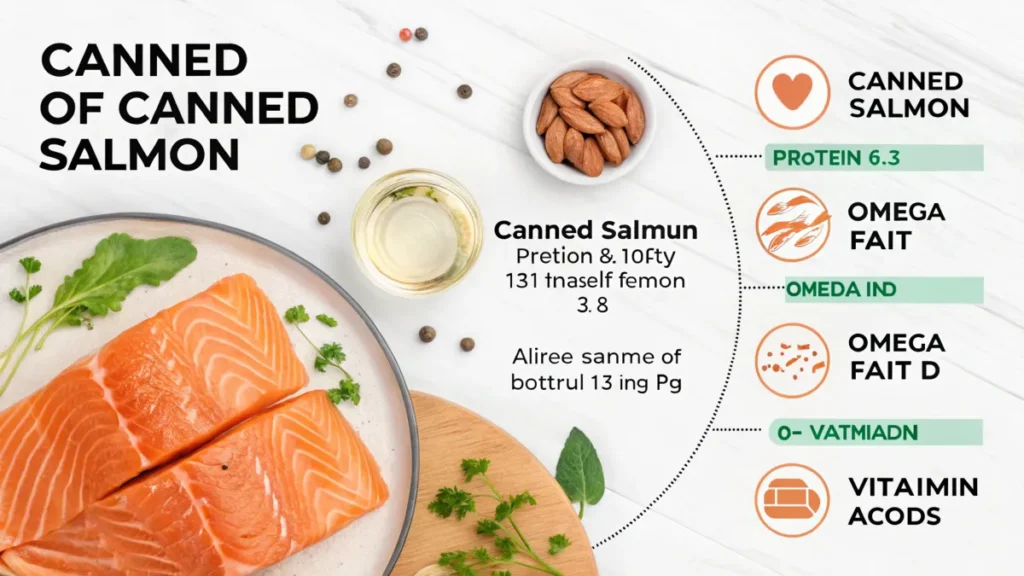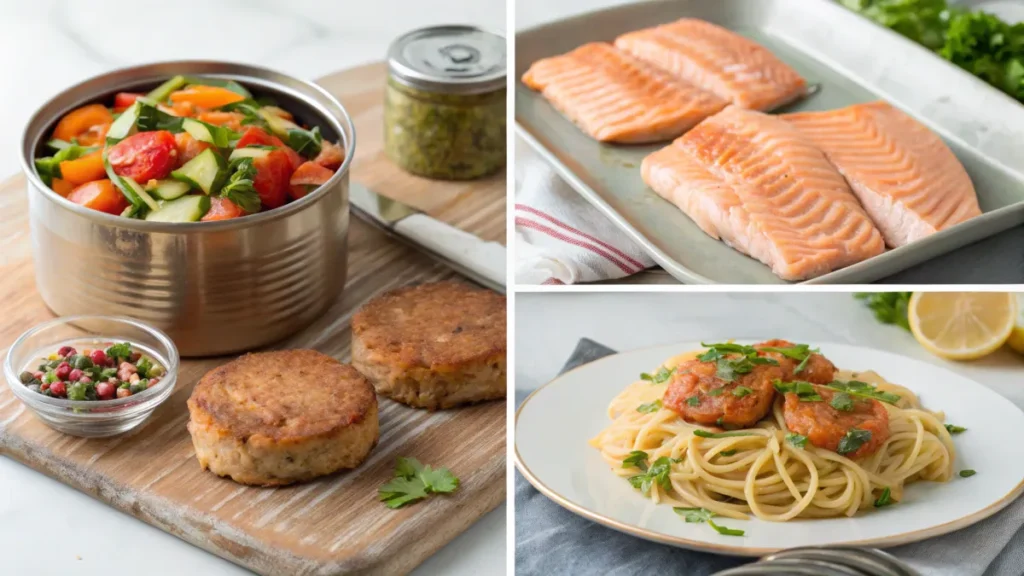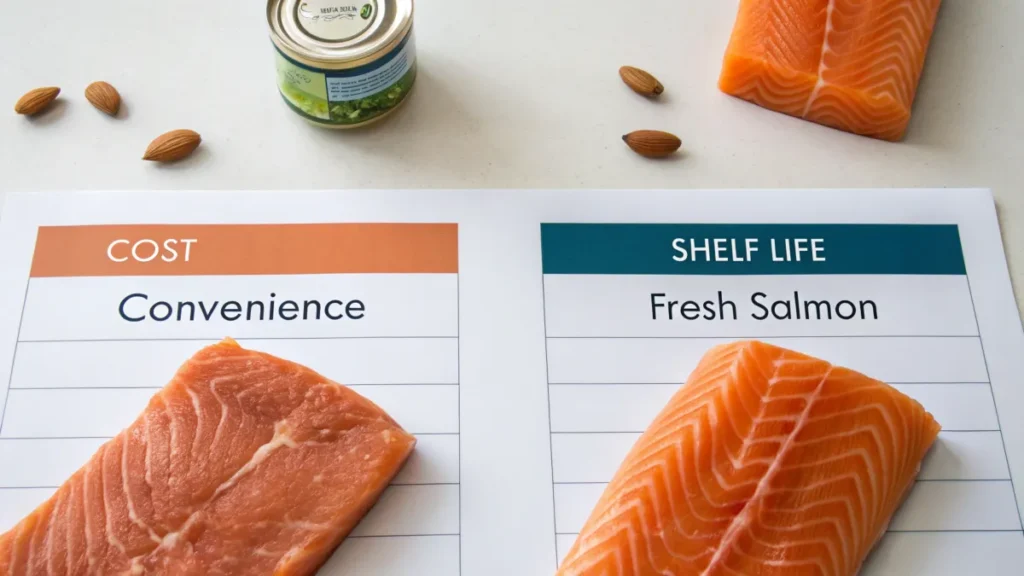Hey there, seafood lovers! Ever found yourself staring at a can of salmon in your pantry, wondering, “Can canned salmon be cooked?” Well, you’re in for a treat! This article is your go-to guide for all things canned salmon. We’ll dive into what it is, how it’s made, and yes, whether you can cook it. Plus, we’ll share some mouthwatering recipes and tips to make the most of this convenient pantry staple. So, let’s get started and turn that can of salmon into a delicious meal!
This guide dives deep into the benefits of cooking canned salmon, various methods to prepare it, common mistakes to avoid, and creative recipes that transform this simple ingredient into extraordinary meals. Additionally, we’ll link to helpful resources such as the Easy Canned Salmon and Rice Bake and the Canned Salmon Buddha Bowl to help inspire your next culinary adventure.
Table of Contents
Understanding Canned Salmon
What is canned salmon?
Let’s kick things off with the basics. Canned salmon is exactly what it sounds like – it’s salmon that’s been preserved in a can. But here’s the kicker: it’s not just any old fish tossed in a tin. Nope, it’s usually wild-caught salmon that’s been cleaned, cut, and then sealed in a can with a bit of salt. Sometimes, you might find a splash of water or oil in there too.
Now, you might be wondering, “Can canned salmon be cooked?” Well, hold your horses! We’ll get to that soon enough. For now, let’s just say that this little can packs a big punch when it comes to nutrition and convenience.
Types of canned salmon
Alright, so you’re standing in the supermarket aisle, and there’s a whole sea of canned salmon in front of you. What’s the deal with all these different types? Well, buckle up, because we’re about to take a quick tour:
- Pink salmon: This is the most common type you’ll find. It’s light in color and has a mild flavor.
- Sockeye salmon: This one’s got a deeper red color and a stronger taste. It’s like the bold cousin of pink salmon.
- Chum salmon: Also known as “keta,” this type is lighter in color and has a milder flavor.
- Coho salmon: This variety sits somewhere between pink and sockeye in terms of color and flavor.
Each type has its own unique taste and texture, so it’s worth trying them all to find your favorite. And guess what? They can all be used in recipes where you might be asking, “Can canned salmon be cooked?“
Nutritional benefits of canned salmon

Now, let’s talk about why canned salmon is such a superstar in the nutrition world. This little can is bursting with good stuff:
- Protein: It’s packed with high-quality protein to keep you feeling full and help build those muscles.
- Omega-3 fatty acids: These are the good fats that your body loves. They’re great for your heart and brain.
- Vitamin D: This sunshine vitamin is crucial for strong bones and a healthy immune system.
- Calcium: Yep, you’ll find this bone-building mineral in canned salmon, especially if you eat the soft bones.
- B vitamins: These help your body turn food into energy.
And the best part? All these nutrients are ready to go, whether you’re wondering, “Can canned salmon be cooked?” or you’re planning to eat it straight from the can. It’s like nature’s multivitamin, all wrapped up in a convenient little package!
So, there you have it a crash course in canned salmon 101. Whether you’re a salmon newbie or a long-time fan, there’s always something new to learn about this versatile food. Stay tuned as we dive deeper into the world of canned salmon in the next sections! To better understand why canned salmon deserves a spot in your kitchen, check out why you should always have canned salmon in your pantry.
The Cooking Status of Canned Salmon
Is canned salmon already cooked?
So, you’re still wondering, “Can canned salmon be cooked?” Well, here’s the scoop: canned salmon is already cooked! That’s right, when you pop open that can, you’re looking at fully cooked fish. This means you can eat it straight away if you want. However, this doesn’t mean you can’t cook it further. In fact, many people prefer to heat it up or use it in cooked recipes.
The canning process explained
Now, let’s take a peek behind the curtain and see how this magic happens. The canning process is pretty neat:
- First, fresh salmon is cleaned and cut into pieces.
- Then, it’s packed into cans, often with a bit of salt.
- Next, the cans are sealed tight to keep out any nasties.
- Finally, the cans are heated to a high temperature. This cooks the salmon and kills any harmful bacteria.
This process not only cooks the salmon but also preserves it, giving it a long shelf life. So, when you’re pondering “Can canned salmon be cooked?“, remember it’s already been through a cooking process.
Safety considerations for consuming canned salmon
Even though canned salmon is pre-cooked, there are still some safety tips to keep in mind:
- Always check the can for any dents, rust, or bulges before opening.
- Once opened, store any unused salmon in the fridge and eat within 3-4 days.
- If you’re pregnant or have a weakened immune system, you might want to heat the salmon before eating, just to be extra safe.
Remember, while you can eat canned salmon straight from the can, many people still prefer to heat it up or incorporate it into cooked dishes. It’s all about personal preference!
Ways to Prepare Canned Salmon

Eating canned salmon straight from the can
Let’s start with the simplest way to enjoy canned salmon. Yes, you can eat it straight from the can! Here are some quick ideas:
- Flake it onto a salad for a protein boost.
- Spread it on crackers for a quick snack.
- Mix it with a bit of mayo and lemon juice for an instant salmon salad.
These methods are perfect when you’re short on time or just don’t feel like cooking. Plus, they’re a great way to enjoy the natural flavors of the salmon.
Simple no-cook recipes using canned salmon
Now, let’s get a bit more creative without turning on the stove. Here are some no-cook ideas:
- Salmon and avocado toast: Mash some avocado on toast and top with flaked salmon.
- Salmon wrap: Mix salmon with Greek yogurt, diced cucumber, and dill. Wrap in a tortilla.
- Salmon sushi bowl: Combine salmon with cooked rice, sliced avocado, and cucumber. Drizzle with soy sauce.
These recipes show that the question “Can canned salmon be cooked?” isn’t always relevant. You can make delicious meals without any cooking at all!
Cooking methods for canned salmon
But what if you do want to heat things up? No problem! Here are some ways to cook canned salmon:
- Pan-frying: Shape the salmon into patties and fry until golden.
- Baking: Mix salmon with breadcrumbs and eggs, then bake in the oven for a crispy top.
- Sautéing: Heat some oil in a pan and sauté the salmon with veggies for a quick stir-fry.
So, can canned salmon be cooked? Absolutely! While it’s already cooked in the can, these methods can add new flavors and textures to your meal.
Remember, whether you’re eating it cold or hot, canned salmon is a versatile ingredient that can be used in countless delicious ways. In the next section, we’ll dive into some specific recipes to try. Stay tuned!
Try the Easy Canned Salmon and Rice Bake for a creamy and satisfying baked dish.
Delicious Recipes Using Canned Salmon
Salmon patties or cakes
Let’s kick things off with a classic! Salmon patties are not only tasty but also super easy to make. Here’s a simple recipe:
- Mix canned salmon with breadcrumbs, an egg, and your favorite herbs.
- Shape into patties and fry until golden brown.
- Serve with a squeeze of lemon and a side salad.
These patties are a great way to answer the question, “Can canned salmon be cooked?” Not only can it be cooked, but it can be transformed into a delicious meal!
Salmon salads and sandwiches
For a lighter option, why not try a salmon salad or sandwich? Here’s a quick idea:
- Flake the canned salmon and mix with mayo, diced celery, and a splash of lemon juice.
- Spread on whole grain bread or serve over a bed of lettuce.
This simple recipe is perfect for a quick lunch or light dinner. Plus, it’s a great way to get those omega-3s!
Hot dishes featuring canned salmon
Now, let’s heat things up with some warm salmon dishes:
- Salmon pasta: Toss flaked salmon with cooked pasta, cream sauce, and peas.
- Salmon quiche: Mix salmon into your favorite quiche recipe for a protein-packed twist.
- Salmon fried rice: Stir fry canned salmon with day-old rice, veggies, and soy sauce.
These recipes show that canned salmon can be just as versatile as fresh salmon in hot dishes.
Tips for Buying and Storing Canned Salmon
Choosing high-quality canned salmon
When you’re at the store, keep these tips in mind:
- Look for wild-caught salmon if possible.
- Check the expiration date.
- Avoid cans with dents or bulges.
- Consider trying different types (pink, sockeye, etc.) to find your favorite.
Remember, good quality canned salmon is key to delicious meals!
Understanding labels and certifications
Labels can be confusing, but here’s what to look for:
- “Wild-caught” means the salmon was caught in its natural habitat.
- “MSC certified” indicates sustainable fishing practices.
- “Boneless and skinless” is great for easy eating, but “bone-in” often has more calcium.
Understanding these labels will help you make informed choices.
Proper storage and shelf life of canned salmon
Once you’ve got your canned salmon home:
- Store unopened cans in a cool, dry place.
- They can last up to 3 years past the “best by” date if stored properly.
- Once opened, transfer any leftovers to an airtight container and refrigerate.
- Use opened salmon within 3-4 days.
With proper storage, you’ll always have delicious salmon ready for your next meal!
Comparing Canned Salmon to Fresh Salmon

Taste and texture differences
When it comes to salmon, many people wonder about the differences between canned and fresh. So, let’s dive in and explore this tasty topic!
Firstly, canned salmon has a softer texture compared to fresh salmon. This is because the canning process cooks the fish, making it tender and flaky. On the other hand, fresh salmon has a firmer texture when raw and becomes flaky when cooked.
As for taste, canned salmon often has a milder flavor than fresh salmon. However, this doesn’t mean it’s less delicious! In fact, many people enjoy the subtle taste of canned salmon, especially when used in recipes. Plus, you don’t have to worry about the question “Can canned salmon be cooked?” because it’s already cooked and ready to eat!
Convenience factors
Now, let’s talk about convenience. This is where canned salmon really shines! Here are some reasons why:
- Long shelf life: Canned salmon can last for years in your pantry.
- No preparation needed: It’s already cooked, so you can eat it straight from the can.
- Always available: You don’t have to worry about salmon being out of season.
Fresh salmon, while delicious, requires more planning. You need to buy it fresh, store it properly, and cook it within a few days. So, if you’re looking for a quick and easy meal option, canned salmon is your best bet!
Cost comparison
Lastly, let’s talk about your wallet. Generally, canned salmon is more budget-friendly than fresh salmon. Here’s why:
- It’s often cheaper per pound than fresh salmon.
- There’s no waste – you use the entire contents of the can.
- You save on electricity or gas since you don’t need to cook it.
While fresh salmon can be a lovely treat, canned salmon offers great value for your money, especially for everyday meals.
Health and Sustainability Aspects
Health benefits of including canned salmon in your diet
Let’s explore why canned salmon is a nutritional powerhouse:
- High in protein: It helps build and repair tissues in your body.
- Rich in omega-3 fatty acids: These are great for heart and brain health.
- Excellent source of vitamin D: This is crucial for strong bones and a healthy immune system.
- Contains calcium: Especially if you eat the soft bones, which are perfectly safe to consume.
So, when you’re wondering “Can canned salmon be cooked?”, remember that it’s not just about cooking – it’s about nourishing your body with every bite!
Environmental impact of canned vs. fresh salmon
Now, let’s talk about our planet. Both canned and fresh salmon have environmental impacts, but there are some differences:
- Transportation: Canned salmon often has a lower carbon footprint because it doesn’t require refrigeration during transport.
- Waste: There’s typically less waste with canned salmon since the entire fish is used.
- Energy use: Canned salmon doesn’t require additional cooking, potentially saving energy.
However, it’s important to note that the fishing methods used can have a significant impact on the environment, regardless of whether the salmon is canned or sold fresh.
Sustainable fishing practices in the canned salmon industry
Finally, let’s look at sustainability in the canned salmon industry:
- Many canned salmon brands use wild-caught fish, which can be more sustainable than farmed salmon.
- Look for labels like MSC (Marine Stewardship Council) certified, which indicate sustainable fishing practices.
- Some companies are working to reduce their carbon footprint in the canning process.
By choosing sustainably sourced canned salmon, you’re not only enjoying a healthy meal but also supporting responsible fishing practices.
Remember, whether you’re eating it straight from the can or using it in a recipe, canned salmon is a versatile, healthy, and sustainable choice. So next time you’re in the grocery store, why not pick up a can and try out some of the delicious recipes we’ve discussed?
Certainly! I’ll create a conclusion section for the article. I’ll follow all the guidelines you’ve provided, including using the keyword, ensuring readability, and maintaining a natural, engaging tone.
Frequently Asked Questions (FAQs)
Is canned salmon safe to eat?
Yes, canned salmon is safe to eat. It undergoes a preservation process that cooks the salmon and seals it in a can, effectively sterilizing the contents.
Can I use canned salmon in recipes?
Absolutely! Canned salmon can be used in a variety of recipes such as salads, sandwiches, and pasta dishes.
Is canned salmon as healthy as fresh salmon?
While canned salmon is not as nutritious as fresh salmon, it is still a good source of omega-3 fatty acids and protein.
Does canned salmon contain bones?
Yes, many canned salmon products contain bones, which are soft and safe to eat. They also add extra calcium to your diet.
Conclusion: Embracing the Versatility of Canned Salmon
Recap of Key Points
So, we’ve taken quite a journey through the world of canned salmon, haven’t we? Let’s take a moment to recap what we’ve learned:
- Canned salmon is already cooked, which answers our big question: “Can canned salmon be cooked?” While it’s pre-cooked, you can certainly heat it up or use it in cooked recipes.
- It’s packed with nutrients like protein, omega-3 fatty acids, and vitamin D.
- You can enjoy it straight from the can or use it in a variety of delicious recipes.
- Compared to fresh salmon, canned salmon is more convenient and often more budget-friendly.
- It’s generally a sustainable choice, especially when you opt for brands with certifications like MSC.
Final Thoughts on Canned Salmon
In conclusion, canned salmon is a true kitchen hero. It’s not just about asking, “Can canned salmon be cooked?” It’s about recognizing its versatility and convenience. Whether you’re whipping up a quick lunch, preparing a family dinner, or looking for a healthy snack, canned salmon has got you covered.
Moreover, by choosing canned salmon, you’re not just making a tasty choice, but also a smart one for your health and potentially for the environment. It’s a great way to include more fish in your diet without breaking the bank or spending hours in the kitchen.
Encouragement to Try Canned Salmon
So, why not give canned salmon a try? Next time you’re at the grocery store, pick up a can or two. Experiment with some of the recipes we’ve discussed, or come up with your own creations. You might just find that this humble canned fish becomes a staple in your pantry.
Remember, cooking is all about exploration and enjoyment. Don’t be afraid to get creative with your canned salmon. Who knows? You might discover your new favorite dish!
So, are you ready to embark on your canned salmon culinary adventure? Your taste buds (and your body) will thank you!

